- Home
- Susan Wittig Albert
The Tale of Oat Cake Crag
The Tale of Oat Cake Crag Read online
Table of Contents
Title Page
Copyright Page
Dedication
Chapter 1 - The Professor Is Perplexed
Chapter 2 - Miss Potter Takes the Case
Chapter 3 - The Professor Puts His Foot in It
Chapter 4 - Splash and Sizzle
Chapter 5 - In Which We Learn About Secret Lives
Chapter 6 - “Welcome Back, Miss Potter!”
Chapter 7 - Tales of a Disappointed Dragon Census-Taker
Chapter 8 - At the Tower Bank Arms
Chapter 9 - A Badger Makes a Chilling Discovery
Chapter 10 - “Is He Dead?”
Chapter 11 - Miss Potter Investigates: At Rose Cottage and the Post Office
Chapter 12 - Miss Potter Investigates: At Belle Green
Chapter 13 - Mr. Heelis and Captain Woodcock Investigate
Chapter 14 - The Professor Investigates: Spy in the Sky
Chapter 15 - Miss Potter Investigates: At the Vicarage
Chapter 16 - In Which Bosworth Is Surprised and the Dragon Learns More About ...
Chapter 17 - “No Proposals, I Say!”
Chapter 18 - “Do Say It’s Wonderful!”
Chapter 19 - “Read This!”
Chapter 20 - In Which We Learn More About Letters
Chapter 21 - “A Half-Mad Wizard”
Chapter 22 - The Dragon and the Owl Hatch a Scheme
Chapter 23 - Miss Potter, Mr. Heelis, and the Letters
Chapter 24 - The Storm
Chapter 25 - In Which We Tie Up All the Loose Ends—But One
Historical Note
Resources
Recipes
Glossary
China Bayles Mysteries by Susan Wittig Albert
THYME OF DEATH
WITCHES’ BANE
HANGMAN’S ROOT
ROSEMARY REMEMBERED
RUEFUL DEATH
LOVE LIES BLEEDING
CHILE DEATH
LAVENDER LIES
MISTLETOE MAN
BLOODROOT
INDIGO DYING
A DILLY OF A DEATH
DEAD MAN’S BONES
BLEEDING HEARTS
SPANISH DAGGER
NIGHTSHADE
WORMWOOD
HOLLY BLUES
AN UNTHYMELY DEATH
CHINA BAYLES’ BOOK OF DAYS
With her husband, Bill Albert, writing as Robin Paige
DEATH AT BISHOP’S KEEP
DEATH AT GALLOWS GREEN
DEATH AT DAISY’S FOLLY
DEATH AT DEVIL’S BRIDGE
DEATH AT ROTTINGDEAN
DEATH AT WHITECHAPEL
DEATH AT EPSOM DOWNS
DEATH AT DARTMOOR
DEATH AT GLAMIS CASTLE
DEATH IN HYDE PARK
DEATH AT BLENHEIM PALACE
DEATH ON THE LIZARD
The Cottage Tales of Beatrix Potter by Susan Wittig Albert
THE TALE OF HILL TOP FARM
THE TALE OF HOLLY HOW
THE TALE OF CUCKOO BROW WOOD
THE TALE OF HAWTHORN HOUSE
THE TALE OF BRIAR BANK
THE TALE OF APPLEBECK ORCHARD
THE TALE OF OAT CAKE CRAG
Nonfiction books by Susan Wittig Albert
WRITING FROM LIFE
WORK OF HER OWN
THE BERKLEY PUBLISHING GROUP
Published by the Penguin Group
Penguin Group (USA) Inc.
375 Hudson Street, New York, New York 10014, USA
Penguin Group (Canada), 90 Eglinton Avenue East, Suite 700, Toronto, Ontario M4P 2Y3, Canada
(a division of Pearson Penguin Canada Inc.)
Penguin Books Ltd., 80 Strand, London WC2R 0RL, England
Penguin Group Ireland, 25 St. Stephen’s Green, Dublin 2, Ireland (a division of Penguin Books Ltd.)
Penguin Group (Australia), 250 Camberwell Road, Camberwell, Victoria 3124, Australia
(a division of Pearson Australia Group Pty. Ltd.)
Penguin Books India Pvt. Ltd., 11 Community Centre, Panchsheel Park, New Delhi—110 017, India
Penguin Group (NZ), 67 Apollo Drive, Rosedale, North Shore 0632, New Zealand
(a division of Pearson New Zealand Ltd.)
Penguin Books (South Africa) (Pty.) Ltd., 24 Sturdee Avenue, Rosebank, Johannesburg 2196,
South Africa
Penguin Books Ltd., Registered Offices: 80 Strand, London WC2R 0RL, England
This book is an original publication of The Berkley Publishing Group.
This is a work of fiction. Names, characters, places, and incidents either are the product of the author’s imagination or are used fictitiously, and any resemblance to actual persons, living or dead, business establishments, events, or locales is entirely coincidental. The publisher does not have any control over and does not assume any responsibility for author or third-party websites or their content.
Copyright © 2010 by Susan Wittig Albert.
All rights reserved.
No part of this book may be reproduced, scanned, or distributed in any printed or electronic form without permission. Please do not participate in or encourage piracy of copyrighted materials in violation of the author’s rights. Purchase only authorized editions.
BERKLEY® PRIME CRIME and the PRIME CRIME logo are trademarks of Penguin Group
(USA) Inc.
Library of Congress Cataloging-in-Publication Data
Albert, Susan Wittig.
eISBN : 978-1-101-45990-4
1. Potter, Beatrix, 1866-1943—Fiction. 2. Women authors—Fiction. 3. Women artists—Fiction. 4. Human-animal relationships—Fiction. 5. Animals—Fiction. 6. Villages—Fiction.
7. England—Fiction. I. Title.
PS3551.L2637T36 2010
813’.54—dc22 2010008218
http://us.penguingroup.com
For Dani Greer and my sisters
at the Story Circle Lifewriters’ Group
who are always ready with a virtual cup of tea,
a scone, and a cheerful word
Cast of Characters (* indicates an actual historical person or creature)
People of the Land Between the Lakes
Beatrix Potter* is best known for her children’s books, beginning with The Tale of Peter Rabbit (1901). Miss Potter lives with her parents, Helen and Rupert Potter, at Number Two Bolton Gardens, in South Kensington, London. She spends as much time as possible at Hill Top Farm, in the Lake District village of Near Sawrey. Mr. and Mrs. Jennings and their children live in the Hill Top farmhouse and manage the farm while Miss Potter is in London.
Will Heelis,* a solicitor, lives in the nearby market town of Hawkshead and is a frequent visitor to Near Sawrey. He and Miss Potter became secretly engaged in The Tale of Applebeck Orchard.
Winston Churchill,* First Lord of the Admiralty, is an ardent supporter of aeroplane development and a visitor to the aeroplane factory.
Mr. Fred L. Baum, landowner and aeroplane developer, lives at Lakeshore Manor. His partner and pilot, Oscar Wyatt, also built the aeroplane. Paddy Pratt is a former odd-jobs man at the manor, recently discharged by Mr. Baum.
Captain Miles Woodcock and his new wife, Margaret Nash Woodcock , live in Tower Bank House. Mrs. Woodcock is the former headmistress of Sawrey School. Captain Woodcock is the justice of the peace for Sawrey District.
Dimity Woodcock Kittredge, Captain Woodcock’s sister, is married to Major Christopher Kittredge, the master of Raven Hall. The Kittredges have two small children, Flora and Baby Christopher.
Vicar Samuel Sackett is the vicar of St. Peter’s Church in Far Sawrey. Mrs. Hazel Thompson (a cousin of Agnes Llewellyn) keeps house for him.
Mrs. Gra
ce Lythecoe, a widow who lives in Rose Cottage, is the object of Vicar Sackett’s affection.
Sarah Barwick operates the Anvil Cottage Bakery in Near Sawrey. She is a Modern Woman who wears trousers and rides a bicycle to deliver her baked goods.
Jeremy Crosfield, eighteen, has finished his studies at Kelsick and is currently teaching at Sawrey School. He is an artist and amateur botanist.
Deirdre Malone, seventeen, keeps the accounts for Desmond Sutton’s veterinary practice and helps Rose Sutton manage the eight Sutton children at Courier Cottage.
Caroline Longford, seventeen, a student of music composition at the Royal Academy of London, is visiting her grandmother, Lady Longford, at Tidmarsh Manor.
Lester Barrow operates the village pub, the Tower Bank Arms.
George and Mathilda Crook live at Belle Green, where Mrs. Crook takes in boarders. Mr. Crook is the village blacksmith.
Dick and Agnes Llewellyn live next door to Belle Green, at High Green Gate.
Lucy Skead is the village postmistress. She lives with her husband, Joseph (the sexton at St. Peter’s in Far Sawrey), at Low Green Gate Cottage.
John Braithwaite is the constable for both Near and Far Sawrey. He and his wife, Hannah, live at Croft End Cottage with their children.
Other Creatures of the Land Between the Lakes
Tabitha Twitchit, president of the Village Cat Council, is a calico cat with an orange-and-white bib, currently residing with Mrs. Lythecoe. Crumpet is a handsome gray tabby who covets Tabitha’s place on the Council.
Rascal, a Jack Russell terrier, lives with the Crooks at Belle Green but spends his time managing the daily life of the village.
Winston the pony lives at Hill Top Farm and takes Miss Potter wherever she wants to go.
Professor Galileo Newton Owl, D.Phil., is a tawny owl who conducts advanced studies in astronomy and applied natural history from his home in a hollow beech in Cuckoo Brow Wood and his lookout post atop Oat Cake Crag.
Thorvaald, a teenaged dragon, frequently visits his friend Bailey Badger at Briar Bank. Thackery, a guinea pig, lives there, too.
Hyacinth Badger is in charge of The Brockery, a famous animal hostelry on Holly How. Also in residence: Bosworth Badger XVII, retired from his post as holder of the Badge of Authority; Hyacinth’s mother, Primrose, chief housekeeper; and Parsley, chef.
1
The Professor Is Perplexed
In the northwestern corner of England, in the Land Between the Lakes, March is a month of uncertain weather. One day brings snow and sharp frosts, the next offers mild temperatures and misty fog, and then it turns off blustery, wild, and wet. And whilst the distant fells may shiver under snowy shawls and mufflers of winter-brown bracken, the high mountain becks are festooned with frosty icicles, and the wind howls through the rock cairns, the lower dales hold the promise of green, and on the brightest days, the blue lakes and tarns reflect the bluest of blue skies. In fact, it might be said that March is a month of all weathers, occurring altogether at once.
Our story takes place in March 1912. The previous year had brought many changes to England, including the coronation of a new king. George V had been crowned in June, and the twin villages of Near and Far Sawrey had celebrated the momentous event with a great flower show and a fair. There was a merry-go-round with wooden horses and camels and swans for the children, a concert by the Village Volunteer Band (Lester Barrow on trombone, Lawrence Baldwin on coronet, Tyler Taylor and Clyde Clinder on clarinet, and Sam Stern on the concertina), and a spirited dance exhibition by the Hawkshead Morris Men, kitted out for the occasion in gay vests, ties, sashes, and hats.
After the almost unbearable excitement of this grand event, it had been hard for the village to return to the everyday work of gardening, dairying, haying, and harvesting. But they managed somehow and life went on as usual, more or less. Vicar Sackett performed two marriages in July and August; several new babies were born in September; and in October, three new cottages went up on the outskirts of Far Sawrey, on land that had once been a sheep meadow. New people were moving to the Land Between the Lakes, and some of them brought new ideas and new ways of doing things, which did not sit well with the local folk.
November and December passed without any excitement whatever in the village, although there was plenty going on elsewhere. Captain Miles Woodcock (who serves as justice of the peace for Near and Far Sawrey) read in The Times that the Admiralty, now under the direction of Mr. Winston Churchill, was readying itself for military action against the German Navy, should the need arise. Two new super-dreadnoughts had just been commissioned, with four more planned for 1912. The prospect of a German attack against Belgium (which was what the Admiralty seemed to most fear) was unsettling, not the sort of thing one likes to read in one’s newspaper at one’s breakfast table on a peaceful Monday morning. But the captain was so blissfully happy with his new wife—the former Miss Margaret Nash, head teacher at Sawrey School—that he was able to put his concerns aside, at least for the moment. (If you have not read The Tale of Applebeck Orchard, you might put the title on your reading list, for it tells the story of how this confirmed bachelor came to propose—on his knees, amidst pieces of broken crockery and a spreading puddle of tea and milk—to Miss Nash.)
The new year brought storms, and as usual in the winter, the villagers kept to their firesides as much as possible. January, like the previous months, crept by without incident, except that one of the Braithwaite boys slid down Stony Lane on his toboggan, crashed into the stone wall in front of High Green Gate, and broke his nose. In February, the Windermere ferry suffered a boiler breakdown and was closed for repairs for nearly a week, forcing everyone to stay on one side of the lake or the other, or travel all the way down to the south end, across the River Leven on Newby Bridge, and back again. It was very inconvenient, and all were glad when Henry Stubbs got the ferry operating again, especially because February was cold, and Newby Bridge was six long miles away.
Now it is March, and the weather has warmed. The month has so far been mild, with a snowfall that quickly melted away. On days when the sky is not gray with scudding clouds and the air not thick with mist, the sun is pleased to shed a little extra light on the pleasant landscape below, to warm the red-berried hollies and the backs of wooly gray sheep grazing the hillsides. In fact, I think it is fair to say that there is no place on this earth that gives the sun so much pleasure as this lovely green land, with its rambling rock walls, quiet lanes, tranquil waters, and long, sweet silences.
Ah, those silences! We modern folk, who live with the raucous roar of traffic, the ringing of telephones, the blare of radio and television, and the constant company of tiny gadgets that pour words and music into our ears, may find it hard to imagine how silent it was in the country in those long-ago days. Even people who lived at the time in London never failed to remark the superb silences of the countryside, broken only by the most natural of sounds. On any given day in the Lake District village of Near Sawrey, all that could be heard was the cautionary bleating of Tibbie and Queenie (Herdwick ewes-in-chief at Miss Potter’s Hill Top Farm), and the gossipy conversations of blue tits and finches, who spend the cold months deep in the hedges, busily doing as little as possible. One might occasionally hear the bell at St. Peter’s, or the cheerful ring of George Crook’s blacksmith’s hammer against the anvil, but these sounds seemed as natural as Tibbie and the blue tits. Indeed, this world was so peaceful and serene that you might think you had stepped into a pastoral painting, where the painter had lovingly recorded the whole lovely landscape, including everything but the sound.
Or perhaps not.
Certainly not if you happen to be Professor Galileo Newton Owl, D. Phil., who has just returned from a lengthy visit with Old Brown. The Professor’s cousin lives on an out-of-the way island in Derwentwater (made famous by Miss Beatrix Potter in her book The Tale of Squirrel Nutkin), which is cut off from communication. At this moment, dusk is falling, and the owl, his wings folded neatly, is
perched atop the spreading oak on Oak Cake Crag, one of his favorite lookout posts. From the crag, a massive stone outcrop overlooking the blue waters of Windermere, he can see the full breadth of this fine lake. He cannot see its full length, however, for even though the Professor has excellent eyesight (especially just at dusk), Windermere is nearly eleven miles long, the longest lake in all England.
But he can certainly see and hear enough to be both greatly annoyed and even more greatly perplexed, although I doubt he would want me to tell you this. Professor Owl likes to believe that he knows everything about everything. When he encounters something he doesn’t understand, he becomes highly irritated. (Perhaps you know one or two people who resemble the Professor in this regard.) Just at this moment, he is deeply puzzled, and therefore annoyed and even somewhat frightened, by the enormous lot of noise and commotion produced by an extraordinary winged creature, as big as a boat—no, bigger than a boat, although not quite so big as a barn—that has risen out of the water at a spot near Cockshott Point and is flying up the lake in a northerly direction.
The Professor stared, incredulous. This thing, this ungainly, ungraceful, unbeautiful, boat-like creature, was flying? Flying?
Yes, flying. Not just whizzing along just above the surface of the water like a respectable goose or a Whooper swan, or splashing along first on one foot and then the other, as does the blue-footed booby you have seen in pictures. This creature had left the surface of the water on the far side of the lake and had already reached a height nearly level with the Professor’s oak tree. And as it turned and came closer, our owl could make out that, whilst the thing lacked a proper tail, it seemed to have two extra wings. There were four—four!—altogether, although as far as the owl could make out, none of the four seemed to flap, as of course, all wings should do.
The sight of this alien creature was startling enough, but there was more. Whereas the well-mannered flying creatures of the Professor’s acquaintance honked or hooted or crowed or croaked or quacked (each according to its nature), this one did none of that. Instead, it emitted an uncivil, earsplitting, high-pitched, frantic drone, like a billion buzzing bees, punctuated by ragged, irregular clattering coughs, quite as if the thing were choking to death.

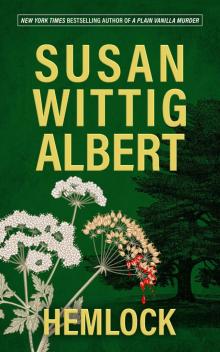 Hemlock
Hemlock Chile Death
Chile Death The Tale of Briar Bank
The Tale of Briar Bank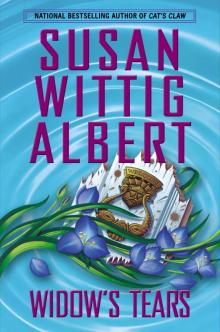 Widow's Tears
Widow's Tears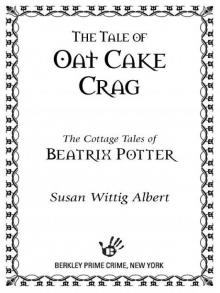 The Tale of Oat Cake Crag
The Tale of Oat Cake Crag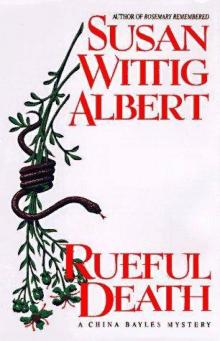 Rueful Death
Rueful Death Bittersweet
Bittersweet The Darling Dahlias and the Poinsettia Puzzle
The Darling Dahlias and the Poinsettia Puzzle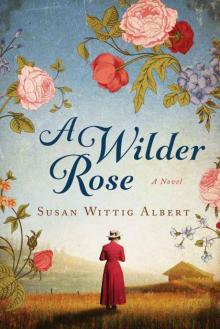 A Wilder Rose: A Novel
A Wilder Rose: A Novel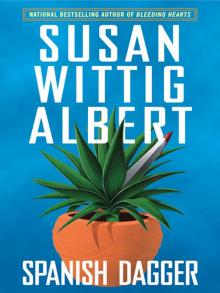 Spanish Dagger
Spanish Dagger The Darling Dahlias and the Texas Star
The Darling Dahlias and the Texas Star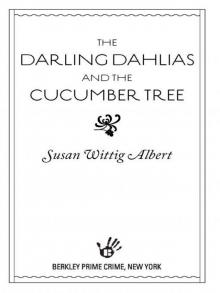 The Darling Dahlias and the Cucumber Tree
The Darling Dahlias and the Cucumber Tree China Bayles' Book of Days
China Bayles' Book of Days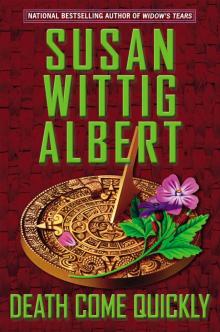 Death Come Quickly
Death Come Quickly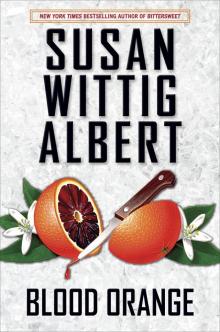 Blood Orange: A China Bayles Mystery
Blood Orange: A China Bayles Mystery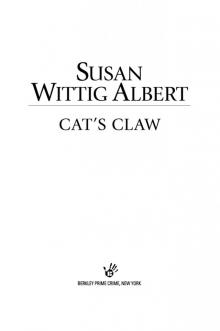 Cat's Claw
Cat's Claw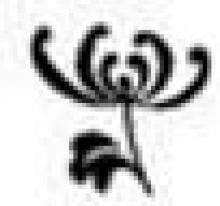 The Darling Dahlias and the Naked Ladies
The Darling Dahlias and the Naked Ladies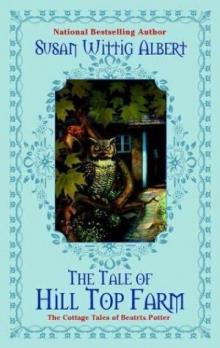 The Tale of Hill Top Farm
The Tale of Hill Top Farm The Darling Dahlias and the Confederate Rose
The Darling Dahlias and the Confederate Rose The Darling Dahlias and the Silver Dollar Bush
The Darling Dahlias and the Silver Dollar Bush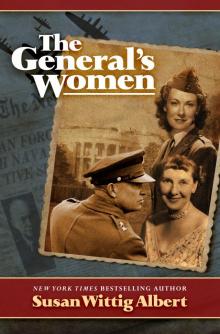 The General's Women
The General's Women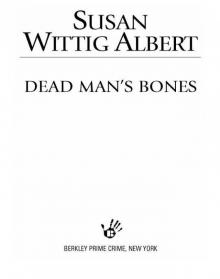 Dead Man's Bones
Dead Man's Bones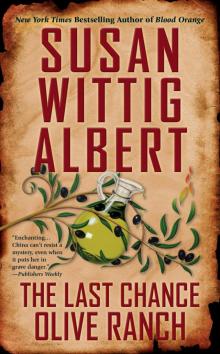 The Last Chance Olive Ranch
The Last Chance Olive Ranch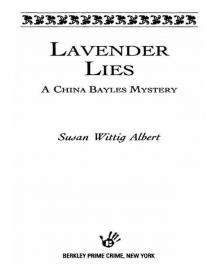 Lavender Lies
Lavender Lies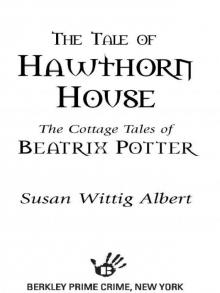 The Tale of Hawthorn House
The Tale of Hawthorn House The Tale of Castle Cottage
The Tale of Castle Cottage Rosemary Remembered - China Bayles 04
Rosemary Remembered - China Bayles 04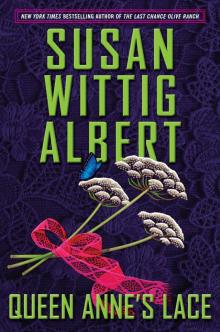 Queen Anne's Lace
Queen Anne's Lace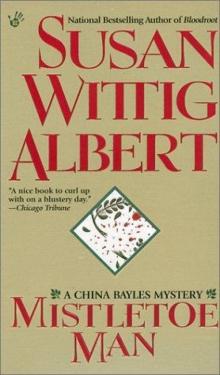 Mistletoe Man - China Bayles 09
Mistletoe Man - China Bayles 09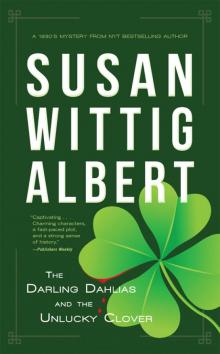 The Darling Dahlias and the Unlucky Clover
The Darling Dahlias and the Unlucky Clover Mourning Gloria
Mourning Gloria The Darling Dahlias and the Eleven O'Clock Lady
The Darling Dahlias and the Eleven O'Clock Lady